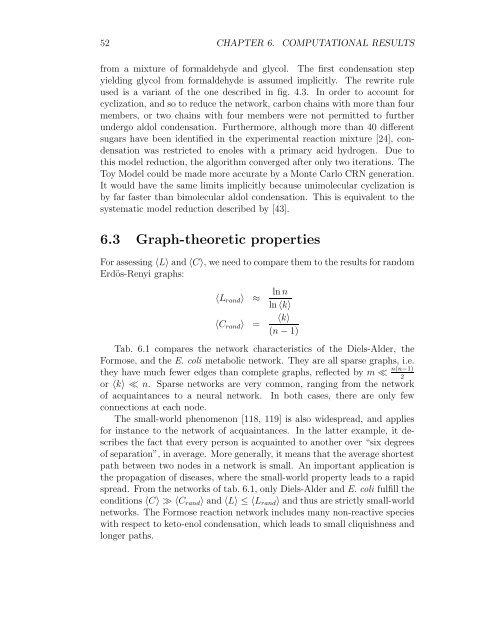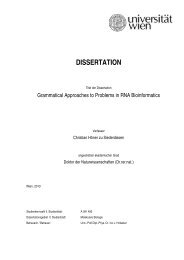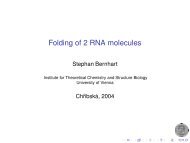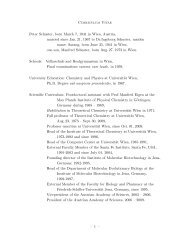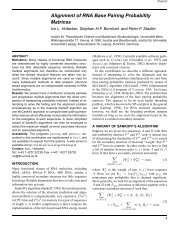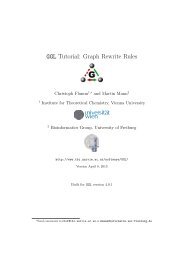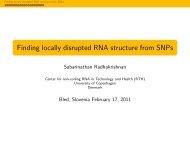A Toy Model of Chemical Reaction Networks - TBI - Universität Wien
A Toy Model of Chemical Reaction Networks - TBI - Universität Wien
A Toy Model of Chemical Reaction Networks - TBI - Universität Wien
Create successful ePaper yourself
Turn your PDF publications into a flip-book with our unique Google optimized e-Paper software.
52 CHAPTER 6. COMPUTATIONAL RESULTS<br />
from a mixture <strong>of</strong> formaldehyde and glycol. The first condensation step<br />
yielding glycol from formaldehyde is assumed implicitly. The rewrite rule<br />
used is a variant <strong>of</strong> the one described in fig. 4.3. In order to account for<br />
cyclization, and so to reduce the network, carbon chains with more than four<br />
members, or two chains with four members were not permitted to further<br />
undergo aldol condensation. Furthermore, although more than 40 different<br />
sugars have been identified in the experimental reaction mixture [24], condensation<br />
was restricted to enoles with a primary acid hydrogen. Due to<br />
this model reduction, the algorithm converged after only two iterations. The<br />
<strong>Toy</strong> <strong>Model</strong> could be made more accurate by a Monte Carlo CRN generation.<br />
It would have the same limits implicitly because unimolecular cyclization is<br />
by far faster than bimolecular aldol condensation. This is equivalent to the<br />
systematic model reduction described by [43].<br />
6.3 Graph-theoretic properties<br />
For assessing 〈L〉 and 〈C〉, we need to compare them to the results for random<br />
Erdös-Renyi graphs:<br />
〈L rand 〉 ≈ ln n<br />
ln 〈k〉<br />
〈k〉<br />
〈C rand 〉 =<br />
(n − 1)<br />
Tab. 6.1 compares the network characteristics <strong>of</strong> the Diels-Alder, the<br />
Formose, and the E. coli metabolic network. They are all sparse graphs, i.e.<br />
they have much fewer edges than complete graphs, reflected by m ≪ n(n−1)<br />
2<br />
or 〈k〉 ≪ n. Sparse networks are very common, ranging from the network<br />
<strong>of</strong> acquaintances to a neural network. In both cases, there are only few<br />
connections at each node.<br />
The small-world phenomenon [118, 119] is also widespread, and applies<br />
for instance to the network <strong>of</strong> acquaintances. In the latter example, it describes<br />
the fact that every person is acquainted to another over “six degrees<br />
<strong>of</strong> separation”, in average. More generally, it means that the average shortest<br />
path between two nodes in a network is small. An important application is<br />
the propagation <strong>of</strong> diseases, where the small-world property leads to a rapid<br />
spread. From the networks <strong>of</strong> tab. 6.1, only Diels-Alder and E. coli fulfill the<br />
conditions 〈C〉 ≫ 〈C rand 〉 and 〈L〉 ≤ 〈L rand 〉 and thus are strictly small-world<br />
networks. The Formose reaction network includes many non-reactive species<br />
with respect to keto-enol condensation, which leads to small cliquishness and<br />
longer paths.


